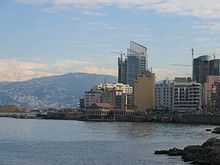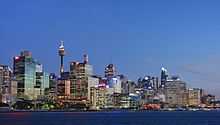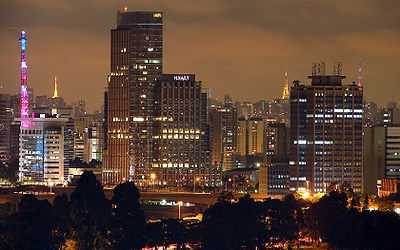Metropolis

.jpg)
A metropolis is a large city or urban area which is a significant economic, political, and cultural center for a country or region, and an important hub for regional or international connections, commerce, and communications. The term is Greek and means the "mother city" of a colony (in the ancient sense), that is, the city which sent out settlers. This was later generalized to a city regarded as a center of a specified activity, or any large, important city in a nation.
Big cities belonging to a larger urban agglomeration, but which are not the core of that agglomeration, are not generally considered a metropolis but a part of it. The plural of the word is most commonly metropolises.[1]
For urban centers outside metropolitan areas that generate a similar attraction at smaller scale for their region, the concept of the Regiopolis, short regio, was introduced by German professors in 2006.[2]
Antiquity
In the past, metropolis was the designation for a city or state of origin of a colony. Many large cities founded by ancient civilizations have been considered important world metropolises of their times due to their large populations and importance. Some of these ancient metropolises survived until the modern days and are among the world's oldest continuously inhabited cities.
Etymology and modern usage
This is a Greek word, coming from μήτηρ, mḗtēr meaning "mother" and πόλις, pólis meaning "city"/"town", which is how the Greek colonies of antiquity referred to their original cities, with whom they retained cultic and political-cultural connections. The word was used in post-classical Latin for the chief city of a province, the seat of the government and, in particular, ecclesiastically for the seat or see of a metropolitan bishop to whom suffragan bishops were responsible. This usage equates the province with the diocese or episcopal see.
In modern usage the word has come to refer to a metropolitan area, a set of adjacent and interconnected cities clustered around a major urban center. In this sense metropolitan usually means "spanning the whole metropolis" (as in "metropolitan administration"); or "proper of a metropolis" (as in "metropolitan life", and opposed to "provincial" or "rural").
Global city
The concept of a global city (or world city) is of a city that has a direct and tangible effect on global affairs through socioeconomic means. The term has become increasingly familiar, because of the rise of globalization (i.e., global finance, communications, and travel). An attempt to define and categorize world cities by financial criteria was made by the Globalization and World Cities Study Group & Network (GaWC), based primarily at Loughborough University in England. The study ranked cities based on their provision of "advanced producer services" such as accountancy, advertising, finance and law. The Inventory identifies three levels of world cities and several sub-ranks (see GaWC study).
A metropolis is not necessarily a global city—or, being one, it might not be among the top-ranking—due to its standards of living, development, and infrastructures. A metropolis that is also a global city is a global metropolis.
By country
Africa
Egypt
Cairo and Alexandria are considered Egypt's biggest Metropolises.
South Africa
In South Africa, a metropolitan municipality or "Category A municipality" is a municipality which executes all the functions of local government for a conurbation. This is by contrast to areas which are primarily rural, where the local government is divided into district municipalities (comparable to a "county" in the US) and local municipalities. There are eight metropolitan municipalities in South Africa. Big cities belonging to a larger urban agglomeration, but which are not the core of that agglomeration, are not generally considered a metropolis but a part of it. The plural of the word is most commonly metropolises.[1]
Asia
Bangladesh

In the People's Republic of Bangladesh, there are seven metropolitan areas Dhaka, Chittagong, Rajshahi, Khulna, Sylhet, Barisal and Rangpur. Lands are highly priced and residents are considered to have a better urban lifestyle. Special police departments are allotted for the metropolitan cities, and there are city corporations for which mayors are elected for five year regimes. Most of these cities have population density of 35,000/square mile or more. Dhaka is considered a mega city because its population surpasses 10 million.[3]
India

In India, there are 47 metropolitan cities. As of 2014 Census India, the top ten metropolitan cities based on their population are Mumbai, Delhi, Kolkata, Hyderabad, Bengaluru, Chennai, Ahmedabad, Lucknow, Pune, Kochi, Surat, Jaipur, Guwahati etc. Residents of these cities are also entitled to a higher house-rent allowance. The Census Commission defines the qualification for metropolitan city as, "the cities having a population of more than one million and above" and Megacity as, "the cities having a population of more than four million and above".[4]
Indonesia

In Indonesia, the metropolitan cities are in Jabodetabek (Jakarta, Bogor, Depok, Tangerang, Bekasi), the biggest metropolitan area in Southeast Asia and the fifth metropolitan area in the world (2007). The other cities are Surabaya, Bandung, Semarang and Medan.
Israel
In Israel there are four main metropolitan areas: Tel Aviv, Jerusalem, Haifa, Beer Sheva. "Israel Central Bureau of Statistics" has defined the boundaries of metropolitan areas of Tel Aviv, Haifa and Beer Sheva, and divided the metropolitan area concentric rings that define the intensity of the main city links.
Japan

The Japanese legal term to (都) is by designation to be translated as "metropolis".[5] however existing translations predate the designation. Structured like a prefecture instead of a normal city, there is only one to in Japan, namely Tokyo. As of 2008, Japan has 11 other cities with populations greater than one million. The same Kanji character in Chinese, or in generic Japanese (traditional or non-specific), translates variously -- city, municipality, special municipality all qualify.
Lebanon

Beirut, Sidon, and Tripoli are three of the main metropolitan areas along the Lebanese coast. Most of Lebanon's metropolitan areas and biggest cities are situated along the coast.
Pakistan
In Pakistan, the major metropolitan cities are Karachi and Lahore, in which Karachi being the second most populous city of the world after Shanghai, China. Others include the nation's capital, Islamabad, and Faisalabad, which is an industrial hub. Rawalpindi , Peshawar , Hyderabad , Larkana , Sukkur , Quetta , Multan , Gilgit and Mirpurkhas are also metropolitan cities of Pakistan.
Philippines

Metropolitan Manila, or simply Metro Manila, is the metropolitan region encompassing the City of Manila and its surrounding areas in the Philippines. It is composed of 17 cities namely City of Manila, Caloocan, Las Piñas, Makati, Malabon, Mandaluyong, Marikina, Muntinlupa, Navotas, Pasay, Pasig, Parañaque, Quezon City, San Juan, Taguig, Valenzuela, and the Municipality of Pateros. The region is the political, economic, social, cultural, and educational center of the Philippines. As proclaimed by Presidential Decree No. 940, Metro Manila as a whole is the Philippines' seat of government but the City of Manila is the capital. The largest city in the metropolis is Quezon City, while the largest business district is the Makati Central Business District.
South Korea
In the Republic of Korea there are seven special and metropolitan cities at autonomous administrative levels include: Seoul, Busan, Incheon, Daegu, Gwangju, Daejeon and Ulsan.
Turkey
In Turkey the metropolitan cities are described as "büyükşehir belediyesi". There are 17 metropolitan municipalities in Turkey now. The largest by far is İstanbul, followed by Ankara and İzmir.
Europe
Bosnia and Herzegovina

In Bosnia and Herzegovina, country's capital Sarajevo is the only metropolis. Sarajevo is a political, economical, educational, cultural and infrastructural center. Moreover, Sarajevo has a region-wide influence in politics, education, entertainment, media, fashion, science, and the arts. With a metropolitan area of over 600 thousand,[6] it is the third largest city in the region of former Yugoslavia and the fifth largest in the Balkans.
Denmark
Statistics Denmark defines a "storby" (Danish for metropolis) as an area with more than 100,000 inhabitants. Inhabited houses must be within 200 meters of each other, or they are not to be considered a single area. Following that definition, Denmark is home to 4 metropolis: Copenhagen (the national capital, with 1,230,728 people), Aarhus (the largest city of the Jutland-peninsula, with 324,000 people/1.2 million in Greater Aarhus), Odense (170,327 people), and finally Aalborg, with 106,916 inhabitants.
Finland
Finland's capital, Helsinki, along with the neighboring areas form an area of Greater Helsinki, with an approximate population of 1,4 million people. This area is the only metropolis in the country.
Germany

The largest German city by administrative borders is Berlin, while Rhine-Ruhr is the largest metropolitan area (with more than 10 million people). The importance of a city is measured with three groups of indicators, also called metropolitan functions: The decision making and control function, the innovation and competition function and the gateway function. These functions are seen as key domains for metropolitan regions in developing their performance.
In spatial planning a metropolis is usually observed within its regional context, thus the focus is mainly set on the metropolitan regions. These regions can be mono central or multi central. Eleven metropolitan regions have been defined due to these indicators: Berlin-Brandenburg, Bremen-Oldenburg, Dresden-Halle-Leipzig, Frankfurt-Rhine-Main, Hamburg, Hannover-Braunschweig-Göttingen-Wolfsburg, Munich, Nuremberg, Rhine-Neckar, Rhine-Ruhr (with Cologne/Bonn), and Stuttgart.[7]
Italy
Starting January 1st 2015, there will be 14 "metropolitan cities" in Italy. Rome, Milan, Naples and other big cores will take in urban zones from their surrounding areas and merge them into the new entities, which will be home for one out of three Italians. The provinces will remain in the parts of the country not belonging to any Città Metropolitana.[8]
Poland
The Union of Polish Metropolises (Polish: Unia Metropolii Polskich), established in 1990, is an organization of the largest cities in the country. Currently twelve cities are members of the organization, of which 11 have more than a quarter-million inhabitants. The largest metropolitan area in Poland, if ranked solely by the number of inhabitants, is the Silesian Metropolis (in fact a metroplex), with 2 million inhabitants (5 million inhabitants in the Silesian metropolitan area), followed by Warsaw, with 1.7 million inhabitants in the city proper and 2.7 million in the Warsaw metropolitan area. The Silesian Metropolis is an initiative of recent years attempting to unite a large conurbation into one official urban unit. Other Polish metropolises are Kraków, Łódź, Wrocław, Poznań, Tricity, Szczecin and Bydgoszcz.
United Kingdom

In the UK, the term the Metropolis was used to refer to London, or the London conurbation. The term is retained by the London police force, the Metropolitan Police Service (the "Met"). The chief officer of the Metropolitan Police is formally known as the Commissioner of Police of the Metropolis.
Since 1974 six conurbations (outside London) have been known as metropolitan counties, each divided into metropolitan districts. Other conurbations in the United Kingdom are also sometimes considered to be metropolitan areas, most notably the West Midlands (centred on the city of Birmingham), West Yorkshire (centred on the city of Leeds), Greater Manchester and Greater Glasgow which make up the most densely populated areas in the British Isles outside of London.
North America
Canada

Statistics Canada defines a census metropolitan area as one or more adjacent municipalities situated around a major urban core where the urban core has a population of at least 100,000.[9] Canada's largest metropolises are Toronto, Montreal, Vancouver, Ottawa, Calgary and Edmonton.
Mexico
In Mexico, the term metropolis is used to refer to an urban area of economic, political, and cultural importance. Mexico City represents all three factors as it is the country's capital and financial center. Other metropolis are Monterrey and Guadalajara, both metropolitan areas population over 4,000,000 inhabitants.
United States

In the United States, an incorporated area or group of areas having a population more than 50,000 is required to have a metropolitan planning organization in order to facilitate major infrastructure projects and to ensure financial solvency. Thus, a population of 50,000 or greater has been used as a de facto standard to define a metropolis in the United States. A similar definition is used by the United States Census Bureau. The bureau defines a metropolitan statistical area as "at least one urbanized area of 50,000 or more inhabitants."
The six largest metropolitan cities in the USA are New York City, Los Angeles, Chicago, Dallas, Houston, and Philadelphia, with New York City being the largest.
Oceania
Australia

The Government of Australia defines a metropolitan area as any statistical division or district with a population of more than 100,000.[10] According to this definition, there are at least 16 metropolitan areas in Australia, including every state capital. By population the largest of these metropolitan areas is Sydney, New South Wales (urban area population at 2013 Census of 4,757,083) and the smallest is Darwin, Northern Territory (Urban area population at 2011 census of 103,016).
South America
Brazil

In Brazil, São Paulo is the principal metropolis with over 15 million inhabitants. In the larger cities, such as São Paulo and Rio de Janeiro (6.3 million), favelas (slums) grew over decades as people migrated from rural areas in order to find work. The term used in Brazilian Portuguese for a metropolitan area is Região Metropolitana. Others metropolises in Brazil that feature over one million inhabitants include: Belém, Belo Horizonte, Campinas, Curitiba, Florianópolis, Fortaleza, Goiânia, João Pessoa, Manaus, Porto Alegre, Recife etc.
Metropolis as a mainland area
In France, Portugal, Spain, and the Netherlands metropolis (métropole (Fr.) / metrópole (Port.) / metrópoli (Spa.) / metropool (Dutch)) designates the mainland part of a country near or on the European continent; in the case of France, this would mean France without its overseas departments. For Portugal and Spain during the Spanish Empire and Portuguese Empire period, the term was used to designate Portugal or Spain except its colonies (the Ultramar). In France métropole is also used to refer to large agglomerations.
See also
- Other city types
- Lists
- Planning theories
- Other
- Ekistics
- Large Cities Climate Leadership Group
- Sustainable city
- World's largest cities
References
- ↑ "Definition of metropolis". Collins English Dictionary. Retrieved 2012-10-23.
- ↑ Prof. Dr. Iris Reuther (FG Stadt- und Regionalplanung, Universität Kassel): Presentation "Regiopole Rostock". 11 December 2008, retrieved 13 June 2009 (pdf).
- ↑ "South Asia - World Population Day - July 11(South Asia Urban Growth)". Web.worldbank.org. Retrieved 2012-10-29.
- ↑ "Population of UAs/Towns" (PDF). he Registrar General & Census Commissioner, India. p. 3. Retrieved 28 July 2014.
- ↑ "Local Government in Japan" (PDF). Council of Local Authorities for International Relations. p. 41. Retrieved 2007-10-16.
- ↑ http://www.bhas.ba/obavjestenja/Preliminarni_rezultati_bos.pdf
- ↑ "Initiativkreise Europäische Metropolregion in Deutschland: IKM". Deutsche-metropolregionen.org. Retrieved 2012-10-29.
- ↑ http://www.citylab.com/politics/2014/12/how-italy-put-cities-in-charge/383719/
- ↑ "census metropolitan area (cma) and census agglomeration (ca), 2001 census". 2.statcan.ca. Retrieved 2012-10-29.
- ↑ "1217.0.55.001 - Glossary of Statistical Geography Terminology, 2003". Australian Bureau of Statistics.
Further reading
| Wikisource has the text of the 1911 Encyclopædia Britannica article Metropolis. |
- Census.gov, U.S. Census Bureau, About Metropolitan and Micropolitan Statistics
- MetroForum.com, forum dedicated to discussions on metropolis
- Blog.ar2com.de, a podcast with a worldwide analysis of megacities (focus Latin America)
- E-geopolis.eu: research group, university of Paris-Diderot, France
- See Ronald Daus´s bibliography, researcher at the Free University of Berlin
